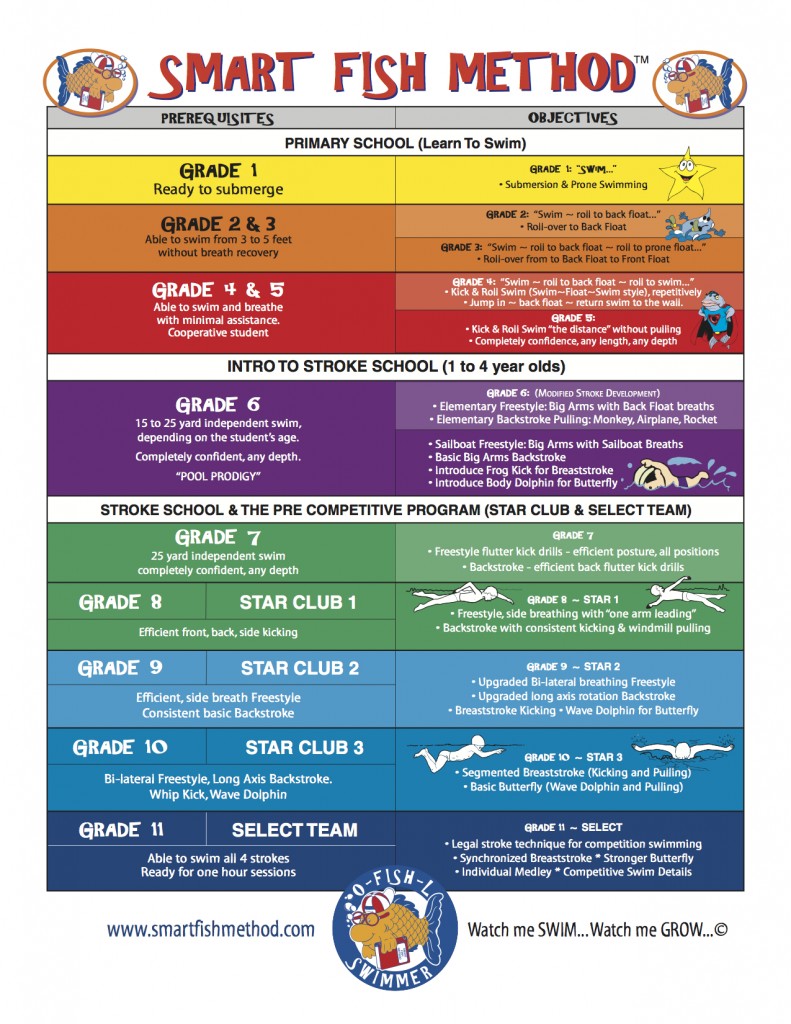WatchВ В MeВ В Swim
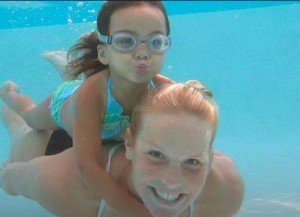 The award-winning “Smart Fish” curriculum was developed by Ginny (Flahive) Ferguson and her expert staff at Watersafe Swim School. Since 1971, this comprehensive method has successfully taught survival skills and advanced technique to thousands of students (from birth to adulthood). The Smart Fish Method has evolved into an orderly schedule of gradients providIng all students with the opportunity to master the fundamentals that efficiently transition into the same winning stroke technique used by the national, world, and Olympic champions.
The award-winning “Smart Fish” curriculum was developed by Ginny (Flahive) Ferguson and her expert staff at Watersafe Swim School. Since 1971, this comprehensive method has successfully taught survival skills and advanced technique to thousands of students (from birth to adulthood). The Smart Fish Method has evolved into an orderly schedule of gradients providIng all students with the opportunity to master the fundamentals that efficiently transition into the same winning stroke technique used by the national, world, and Olympic champions.
All Smart Fish teachers are extensively trained and certified through the Nationally recognized Smart Fish Method Training Program. We believe love and understanding within a structured, innovative environment will produce a safe, happy swimmer. Our loving teachers truly believe that each child is an individual. Therefore, we strive to personalize the instruction to fit each student’s special needs and abilities.

PRINT YOUR OWN PROGRESS REPORTS HERE!
Every step our swimmers take towards water safety and stroke proficiency is important to us and we know it’s important to you. The Smart Fish Method allows you and your child to track this progress throughout your lessons. Simply click on a link below to print out your own progress reports. Your Smart Fish Method teacher will help you fill out your progress report as your child GROWS through the Smart Fish Method.
{image.index}/{image.total}
How is the Smart Fish Method Different?
1. Progressive Learning: Within the first set of lessons, we expect results that will greatly improve their chances to save themselves in the event that they purposely or accidentally enter into any body of water.
2. Personalized Approach: We teach with “Gentle Persuasion”. Whether we emphasize Gentle of Persuasion is up to the parent. We can teach the SFM slowly and gently or through a more accelerated persuasive approach, despite resistance or protest from the student. The teachers are trained to fully communicate with the parent in order to know what is needed and wanted.
It makes more sense than the traditional way that more standard methods teach swimming:
1. To blow or not to blow: We do not teach bubble blowing out of the mouth – we want them to hold their breath underwater, not to exhale underwater & eventually learn to exhale out through their nose.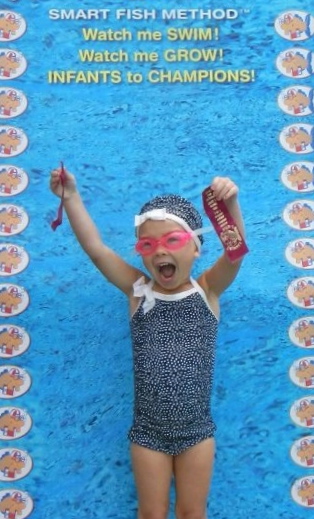
2. Efficient breath recovery: We only allow the students to recover for air by rolling laterally to the back float position – no front, head lifting dog paddle allowed.
3. Efficient transition to advanced stroke technique: We teach breathing and kicking, before we teach pulling with “big arms”.
We do not teach over-arm pulling until after the student can swim across
the pool independently and confidently…by kicking, rolling to
back float & breathe, rolling back over to swim – repeatedly. Freestyle is more easily & efficiently learned if they learn roll-over or lateral breathing first.
“Roll-over swimming”, as opposed to pop-up breath, dog paddle type swimming promotes the needed horizontal “Posture, Line, and Balance” that is the basis for efficient stroke technique.
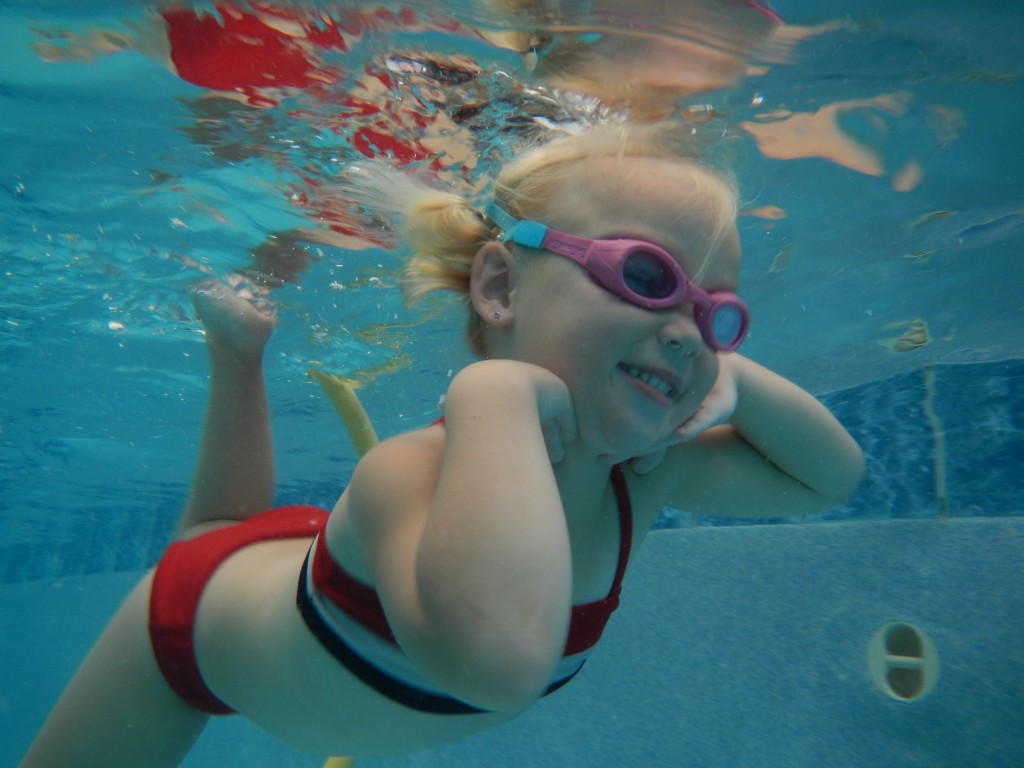
what to expect from the young student
TYPICAL LEARNING STAGES
STAGE 1: The student resists the teacher’s instruction. There is absolutely no co- operation, even when asked to do some of the simplest of tasks, like standing on the platform, reaching, submersion, or leaning back on the teacher’s shoulder.
STAGE 2: The student is more accepting now. When the teacher initiates a skill, the stu- dent does not resist. In fact, as the level of cooperation improves, the student begins to contribute to the teacher’s directives. Teacher and student begin to “dance” with each other. The teacher leads. The student follows. At this point, the teacher is still a crutch.
STAGE 3: The student’s confidence improves. Now he begins initiating the execution of the skill. The student becomes the leader and the teacher is the follower. However, the student still appreciates light spotting from his teacher. Now the teacher is “Dumbo’s Feather”. (In Dis- ney’s story, Dumbo, the elephant was able to fly as long as he held a feather with his trunk.)
STAGE 4: The student is confident and competent enough to execute the skill independently.
TYPICAL EMOTIONAL PHASES
PHASE 1: The new student resists, cries, does not trust, etc… because of fear, uncertainty, caution, etc.
PHASE 2: The student now realizes swimming is OK and FUN. You will notice cooperation, interest, confidence, smiles. At this point, the child should receive her SMART FISH GRADE 3 “I Love 2 Swim” skill card.
PHASE 3: The now very confident student enters into a comfort zone. She will not be ambitious to learn more. She will become resistant again, especially if she is in that very self-determined Age of Contrary (18 months to age 3). Some- times the child will snap out of this plateau when grouped with another child who is more cooperative. If group lessons are not possible, try to schedule the child to be taught privately at the same time as another private lesson student of similar ability and age.
PHASE 4: The student is happy and open to learning again. She wants to improve her skills, because she is finally understanding that improved skills translates to increased fun, especially if it means that she will be more able to keep up with her peers.

MOST COMMONLY ASKED QUESTIONS
No one can be considered absolutely “watersafe”. There is no substitute for adult supervision. It is vital that all babies & children be closely watched when in or near any body of water.
WHEN CAN BABIES START?
Healthy babies (as young as 1 month) can start when the circumcision is healed and the umbilical cord has fallen off. The water should be at least 90 degrees.
WHY START SO YOUNG?
The younger the babies, the more likely they are to accept the water and instruction. Human infants are adapted to swimming. The behaviors of automatic breath holding and swimming movements begin to fade as early as 3 months of age. Exposure to swimming provides the ideal exercise. They are not restricted to gravity and benefit from the cardiovascular exercise it provides. It gives babies a head start in learning basic swimming skills and improves bilateral coordination and balance.
SHOULD PARENTS BE VISIBLE DURING THE CHILD’S LESSON?
If the child is constantly asking for “Mommy or Daddy” throughout the lesson and if the teacher is having trouble competing for attention, it is generally best to have the parent “out of sight and out of mind” until the child begins to bond with and trust the teacher. Often, if the child thinks there is a sympathetic person close by who will “save them” from their “plight”, they will likely become melodramatic and emotionally distressed. We want parents to watch the entire lesson, but often prefer that they hide whenever their child becomes distracted by the possibility that Mom or Dad might bail them out of their situation.
WHAT IF MY CHILD DOESN’T WANT TO TAKE LESSONS?
Please read the article “Safety First and Fun Later” and “In your child’s best interest”. Remember the benefits and the alternative. At first, the child may have very resistant behavior – but eventually, the teacher will bring out THE BEST in your child. We guarantee that you will be indescribably proud of your child (and of yourself) for having persevered.
HOW OFTEN SHOULD LESSONS BE SCHEDULED?
Resistant or fearful students should (at first) attend as many lessons per week as possible. Attending once per week can work, but there will be accelerated success and improvement in attitude and skill, if the student can attend at least two or three days per week, (up to seven days per week). When they begin to enjoy the water and the process of learning, scheduling once or twice per week is acceptable.
HOW LONG DOES IT TAKE THEM TO LEARN?
The teachers use Gentle Persuasion. Sometimes the emphasis is on “Gentle”. Generally, the students learn faster if the emphasis is on “Persuasion”. If the parents prefer the emphasis to be on one or the other, it needs to be communicated to the teacher. Most students learn enough to save themselves – in about 10 to 20
WHAT & WHEN SHOULD THEY EAT BEFORE SWIM?
We recommend that children not eat an uncomfortably large meal before lessons. Beginning swimmers under two years of age should avoid food (especially dairy products) 2 or 3 hrs ahead of each lesson.
EAR INFECTIONS?
There are two types of ear infections-one is caused by middle ear build-up secondary to Eustachian tube congestion & the other is caused by pool or bath water not drying up in the outer ear canal “Swimmers’ Ear”. To prevent the latter, parents can blow dry the ears or use alcohol & boric acid drops available at the school or local pharmacy. Swimming does not cause the middle ear infections. Children with ventilation tubes in their ears can still swim, but should wear ear plugs, a tight fitting cap, and should not swim deeper than a foot below the surface of the water.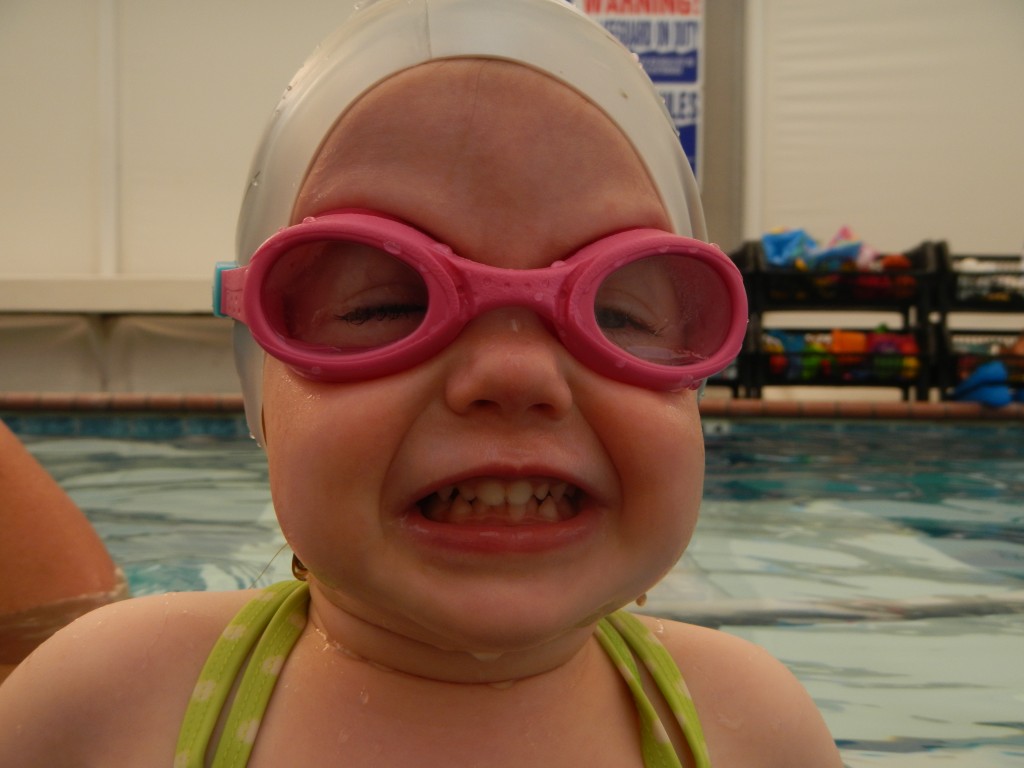
RECOMMENDED & REQUIRED EQUIPMENT:
Goggles – should be double or split strapped and “fogless”. Most good goggles should cost at least $10. Bad goggles can be worse than no goggles. Students tend to learn faster when wearing goggles. The favored brand is sold at the school office. They provide a comfortable and secure fit for all faces: infants to adults.
Caps – Swim caps keep the hair out of the face and to help keep the goggles from slipping on the back of the head. They are recommended for both the boys and girls. We have novelty caps for sale and colored Smart Fish caps that match their Smart Fish Grade Level to recognize their advancement as they progress
Type of suit – Boys should wear the shortest shorts possible. Girls should wear suits with straps that do not fall off the shoulder.
Pool Diapers – If not definitely potty-trained, the child is required to wear a paper & a reusable pool diaper.
Swim Ear Drops – Alcohol & boric acid ear drops to help prevent Swimmers’ Ear
Wet Suits – We have wet suits to keep the children warm & to help with buoyancy & therefore, confidence.
Fins – for strength development, our adjustable snap fins are for sale
Fins make the student feel more powerful in the water and can increase confidence. To avoid dependency on them, do not use them all the time.
TEACHER CHANGES We strive to provide but cannot guarantee the same teacher throughout the term. Often, change is good. It is better for the student to be dependent on himself rather than on the teacher. The child learns coping skills and the perspective of a different teacher can provide new ideas that will help with the learning process.
Testimonials
One Smart Fish…
July 24, 2008 My husband Bob, Jack (2yrs, 3 months), and myself, Julie, went to McKenna’s on the Bay on Wednesday, July 16, 2008. We have been going there for years for appetizers...moreRiver Rescue
20 month old Taylor Mortiz loved the water but couldn’t swim, a scary combination. She fought her lessons, but eventually learned to appreciate her ability to back float, especially when she had to...moreSafe and Sound
3 year old Jamie Utz was riding her tricycle around the swimming pool, caught her wheel on the edge, fell in, back floated, rolled back over, swam to the wall, climbed out and...moreNo Lifeguard on Duty
“Our 18 month old rolled over into a safe back-float position after stumbling in the water at Mother’s Beach…so glad he learned to swim during the spring so he could safely enjoy summer...more
